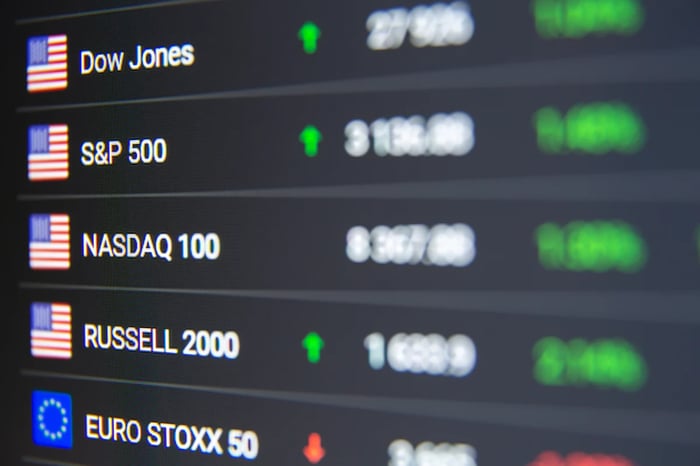The Smartest ETF to Buy With $1,000 Right Now
Key Points
The Invesco Nasdaq 100 ETF is a smart choice for investors who want exposure to a broad range of big growth stocks.
Its favorable fee makes it ideal for buy-and-hold market participants.
It's also a great way to tap into the AI boom.
- 10 stocks we like better than Invesco NASDAQ 100 ETF ›
There's a dizzying array of exchange-traded funds (ETFs) listed in the U.S., and the number grows on a seemingly daily basis. While that sounds daunting in terms of evaluation and selection, there are steps investors can take to make these challenges less burdensome.
New investors and those with small stakes, say $1,000 or thereabouts, can smooth their ETF shopping trips by knowing what they're looking for and embracing the familiar before setting out on their journeys. These days, growth stocks, including those with clear artificial intelligence (AI) ties, are top of mind for many investors.
Where to invest $1,000 right now? Our analyst team just revealed what they believe are the 10 best stocks to buy right now, when you join Stock Advisor. See the stocks »
That's one factor making the Invesco Nasdaq 100 ETF (NASDAQ: QQQM) an alluring choice worthy of an investment of $1,000 or more. QQQM, which turned five years old earlier this month, also checks the familiarity box. Put simply, the ETF is the low-cost alternative to the famous Invesco QQQ Trust (NASDAQ: QQQ). The differences are minor: QQQM charges 0.15% compared to QQQ's 0.20% annual expense ratio. The QQQ has a higher trading volume and tighter bid-ask spreads, which is why it's more appealing to frequent traders. The QQQM, with its lower expense ratio, is designed more for buy-and-hold investors.
A great place to start
Newbie investors are often confounded by mistaken assumptions that you need to select individual stocks and have large sums of money in order to begin investing in the stock market. Neither assumption is true. In fact, a $1,000 investment in QQQM today will likely look significantly more attractive in three, five, or 10 years than leaving that same cash in a savings account.

Image source: Getty Images.
This ETF's track record is impressive. An investor who plunked down $1,000 into the ETF when it launched in October 2020 would have more than $2,100 today, and that's without dollar-cost averaging into the fund over time.
That's a big reward for a small investment, which goes to show that getting into the game, even with tiny stakes, is what matters. Look at it this way: An investor who thought $1,000 wasn't enough to get involved with QQQM five years ago is probably questioning that decision today.
An efficient AI, Magnificent Seven tool
Another reason to invest $1,000 in QQQM is because few non-dedicated tech ETFs offer as much exposure to AI and "Magnificent Seven" tech giants as the Invesco fund. When accounting for Alphabet Class A shares and Alphabet Class C shares, eight of QQQM's top-10 holdings are Magnificent Seven stocks.
That famed group of AI/tech leaders make up nearly 44% of QQQM's roster, confirming that even with just $1,000, investors get broad access to market leaders.
That makes QQQM all the more appealing to the $1,000 crowd because for that amount of money, an investor couldn't buy two shares of Microsoft or even 1.5 shares of Meta Platforms.
QQQM has the goods for small investors
We can't all be Warren Buffett or even get close to Berkshire Hathaway's stratosphere of capital allocation, but that doesn't mean $1,000 can't grow into something significant. QQQM proves that can and does happen.
Speaking of the Oracle of Omaha, one way in which ordinary investors can mimic his style is by embracing companies with durable economic moats. Just 3% of QQQM holdings have no moat, but close to 74% fit the bill as wide moat names.
New investors with just $1,000 to deploy ought to consider QQQM because it has the potential to grow that cash in relatively short-term time frames. Likewise, experienced investors looking to direct $1,000 to greener pastures may find QQQM attractive, particularly if they're taking profits from defensive or value-oriented strategies.
Should you invest $1,000 in Invesco NASDAQ 100 ETF right now?
Before you buy stock in Invesco NASDAQ 100 ETF, consider this:
The Motley Fool Stock Advisor analyst team just identified what they believe are the 10 best stocks for investors to buy now… and Invesco NASDAQ 100 ETF wasn’t one of them. The 10 stocks that made the cut could produce monster returns in the coming years.
Consider when Netflix made this list on December 17, 2004... if you invested $1,000 at the time of our recommendation, you’d have $590,357!* Or when Nvidia made this list on April 15, 2005... if you invested $1,000 at the time of our recommendation, you’d have $1,141,748!*
Now, it’s worth noting Stock Advisor’s total average return is 1,033% — a market-crushing outperformance compared to 193% for the S&P 500. Don’t miss out on the latest top 10 list, available when you join Stock Advisor.
See the 10 stocks »
*Stock Advisor returns as of October 27, 2025
Todd Shriber has positions in Alphabet. The Motley Fool has positions in and recommends Alphabet, Berkshire Hathaway, Meta Platforms, and Microsoft. The Motley Fool recommends the following options: long January 2026 $395 calls on Microsoft and short January 2026 $405 calls on Microsoft. The Motley Fool has a disclosure policy.



